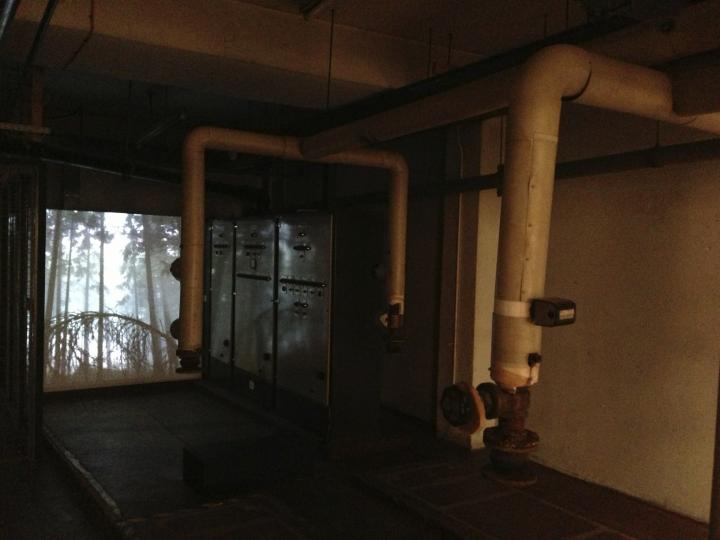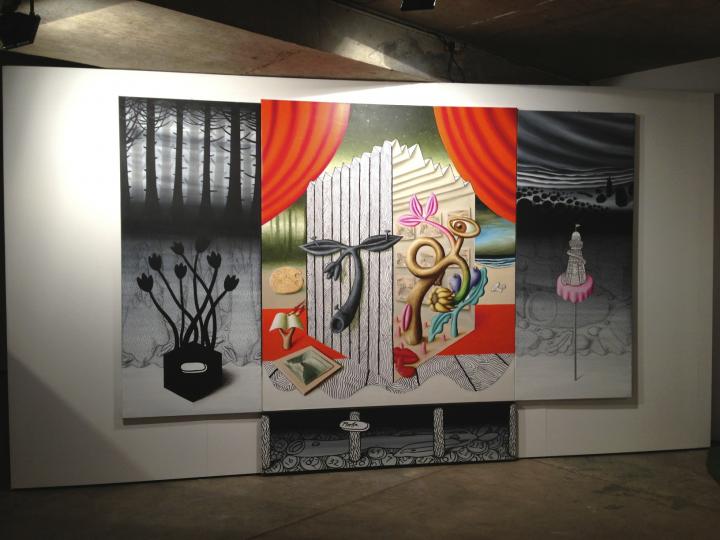There is so much to see in this exhibition, which can be described as an inspiring imaginary landscape of interrelated paintings, sculptures and installations.

The complexity of the visual and conceptual interconnections, the bright colours in the works and the melodic sounds of pinball machines combine skillfully to create a seductively fun and entertaining space. It is ´painted with a jouissance of ludicrous charm, it is hard not to be tickled by Mason´s comic and clever helter-skelter configurations, his cheeky winks towards the sacred and the profane. Eyes on stalks, lips pinned to the trunk of a tree, the spilled guts of dates, badges and signs, arrows, buds and blossoms, reminds us of the polymorphous perverse erotic possiblities of everything. There is excitability here, a clowning around in the paddling pool of life´s sweet disorder.´(1)
This encourages a sense of peace and contemplation, which is in itself a huge achievement in an enclosed underground space devoid of natural light. Alex Gough describes how “Robin’s work is about a journey, so the creation of the exhibition started at the building stage.” (2)
. Expressing the artist as curator, creating walls and specifically modifying the lighting to emphasize the darkness of the space.

As the exhibition ´unfolds around us, it becomes glaringly obvious that these melodies of teenage pastimes are but the soundtrack for a visual and emotional experience of funfair proportions. Prints, etchings, and a vast mind-boggling polyptych paintings jostle up against astroturf lawns, dazzling lights and curiously disorientating mini-museums.´ (3)
The viewer is transported from an obviously industrial space, through the artworks which weave the viewers vision through and around the sculptures, incorporating the unusual and existing features of the exhibition space into a parallel, multiverse landscape. The juxtaposition of the magical electronic dimension autobiographical seaside culture with images of trees, could be described as a comment on the naturalization of technology. (4)

The installation with the same title as the exhibition itself, is a projection of images of nature under duress, lasting 9 minutes and 38 seconds in duration. Stills of dismembered trees and truncated branches are accompanied by the occasional sound of a bell tolling. It references the deeper conceptual meaning of this exhibition, the artists obsession with Grunewalds Isenheim Alterpiece. He writes how ´In Colmar. The Isenheim Altarpiece Speaks, Screams, Whispers, Yells, Rings, Shouts, Squeals. It tells the truth. And it lies. It shows the red. And the fantastic. It is poetic. And operatic. It meanders like a small stream. Then rushes like a torrent, it asks no questions. And asks all questions. It is full of light. It is full of dark. It stands proud. It lies calmly. It denies. it has the pain of the world. It has the pleasures of the world. It is life. It is death. It is evil. It is heavenly. It is faithless. It is faithful. It is me. It is you. It is us. It is them. It is then. It is now. It was, Is, Can, Can´t, Should, Shouldn´t, Will, Won´t, Has, Hasn´t, Did, Didn´t. As the river meanders in the distant landscape, a death assured. As is ours. Its life, as leaves in a book, entangled in us, in Colmar.´(5)
The Isenheim Alterpiece was commissioned for a hospital dedicated to treatment of extreme suffering resulting from a disease that was ascribed to a Claviceps purpurea fungus, which infected Rye, poisoned its victims and developed into convulsions, skin eruptions and ultimately death. (6)
This ultimate expression of suffering has been an inspiration to many thinkers such as Walter Benjamin, and has inspired pivotal and important paintings by artists such as Pablo Picasso (7)
, which culminated in Guernica (8).
The structure of the Alterpiece can be seen in some of the paintings such as ´Between Here and There´ (9)
and the signatory claw-like fingers reaching for the sky, are referenced within the ´Rite of Spring´(10). The connection between all of these responses to the panels is that they are ´less about crucifixions as such but rather about figurations of suffering, about ´imaging´ suffering. The central claims should hold true regardless of whether we are talking about medieval altarpieces or contemporary news photos of the abused inmates of Abu Ghraib´(11)
. Therefore the deconstruction of the crucifixion motif from its narrative framework could be said to focus on ´the very nature of tragedy´ (12).
itself. Which Walter Benjamin described as ´the notion of the expressionless to depict the mute traumas... whom violence has deprived of expression´ (13).
. By transcending religion but focusing on the nature of tragedy I am drawn to the use of trees within the artworks and created as sculptures by the artist, to specifically enhance the exhibition space. Jackson Pollock is described as rejecting art as representation through expressing himself as nature, By ´Using the metaphor of a tree Paul Klee likened the artist to a tree that absorbs energy from nature through ´the roots´, transmits rising sap through ´the trunk´to form the branching ´crown,´an abstract art....the abstract expression of inner natural forces informed by a larger awareness of nature and its rhythms.´(14)
Therefore bring the inner dimensions of nature (as autobiographical and human experience) together with the outer reality of nature, the artists aspires to a oneness between man and nature. This ´harmony between inner and outer landscapes´, is the perfect antidote ´a world saturated with images, this is a tale told with the intent to bring us back to our senses´. Therefore it is vry appropriate that there are multiple references to senses present within the exhibition; the eyes on stalks, the lips on branches.

The artist describes the experience of the trace memory of artwork: ´it was a slow release thing, as if the image of the Island of the Dead had been burnt or branded into my retina...yes...like the afterimage of a light bulb, refusing to fade away´. As the afterimage of a lightbulb is a black spot of temporary blindness, an exhibition who is inherently dark, would in theory have the subtle aftereffect of brightness. As a continuation of this theory, the title of the exhibition could be transformed into an ´the brightest heights´ as an after-image of the exhibition. The process has been described as ´healing in transcription, and although the Altarpiece comes forth from death, in its trsnscribed form, it is ´not a death´, but rather ´a birth, a new beginning´...a bold celebration of the possiblity of this beginning, bravely reminding us that despite the anguish of our inevitable losses, life´s many pleasures can become entirely possible again.´ (15)
The contemplation of the darkness results in the viewer receiving an antidote to darkness. Which is possibly why I left the exhibition feeling so positive and inspired! I strongly encourage you to visit this exhibition, and spread the word!
The Deepest Darkness, by Robin Mason
Until 07.06.13
Thursday-Saturday 12-6,
or by appointment on 0207 998 8337
336 Brixton Road,
London SW9 7AA
Review by Natasha Hall, a practicing artist and Phd student.
Images
Image 1: The exhibition space with multiple artworks
Image 2: Section of Mason, R. (2009-2013) Search and Journey, Oil and Acrylic on Canvas, 274 x 366cm.
Image 3: Mason, R. (2013) The deepest Darkness, Moving image, duration 9m 38sec, Variable Installation.
Image 4: Mason, R. (2013) Between Here and There, Oil and acrylic on canvas, 251 x 363 cm.
References
1 Groves, T. (2013) ´An Antidote to Darkness´, In Mason, R. (2013) The deepest Darkness, Block 336 Ltd. p5.
2 Review by Lizzie Kay, http://www.brixtonblog.com/new-exhibition-the-deepest-darkness-at-block-336/12014
3 Press Release of the exhibition as produced by Block 336.
4 Crowther, P. & Wunsche, I. Eds. (2012) ´Meanings of Abstract Art; Between Nature and Theory´, Taylor & Francis, Routledge, p222.
5 Mason, R. (2013) The Deepest Darkness, Block 336 Ltd. p54-55.
6 Minkkinen, P. (2008) The Expressionless: Law, Ethics and the Imagery of Suffering, Law Critique, Volume 19, Issue 1. p71.
7 Picasso, P. (1930) ´Crucifixion´, Oil on Wood, 52 x 66cm, Musée National Picasso, Paris., Picasso, P. (1932) ´Crucifixion after Grunewald´, Eight inkwashes and ink drawings, 34 x 51cm, Musée National Picasso, Paris. In: Minkkinen, P. (2008) The Expressionless: Law, Ethics and the Imagery of Suffering, Law Critique, Volume 19, Issue 1. p75.
8 Serraler, F. C. & Giménez, C. Eds.(2006) ´Spanish Painting from El Greco to Picasso: Time, Truth and History´, New York, p386-391. In: Minkkinen, P. (2008) The Expressionless: Law, Ethics and the Imagery of Suffering, Law Critique, Volume 19, Issue 1. p75.
9 Mason, R. (2013) Between Here and There, Oil and acrylic on canvas, 251 x 363 cm.
10 Mason, R. (2013 Right of Spring, Oil and acrylic on canvas, 185 x 185 cm.
11 Minkkinen, P. (2008) The Expressionless: Law, Ethics and the Imagery of Suffering, Law Critique, Volume 19, Issue 1. p7o.
12 Ibid. p80.
13 Ibid. p82.
14 Crowther, P. & Wunsche, I. Eds. (2012) ´Meanings of Abstract Art; Between Nature and Theory´, Taylor & Francis, Routledge, p119.
15 Groves, T. (2013) ´An Antidote to Darkness´, In Mason, R. (2013) The deepest Darkness, Block 336 Ltd. p8